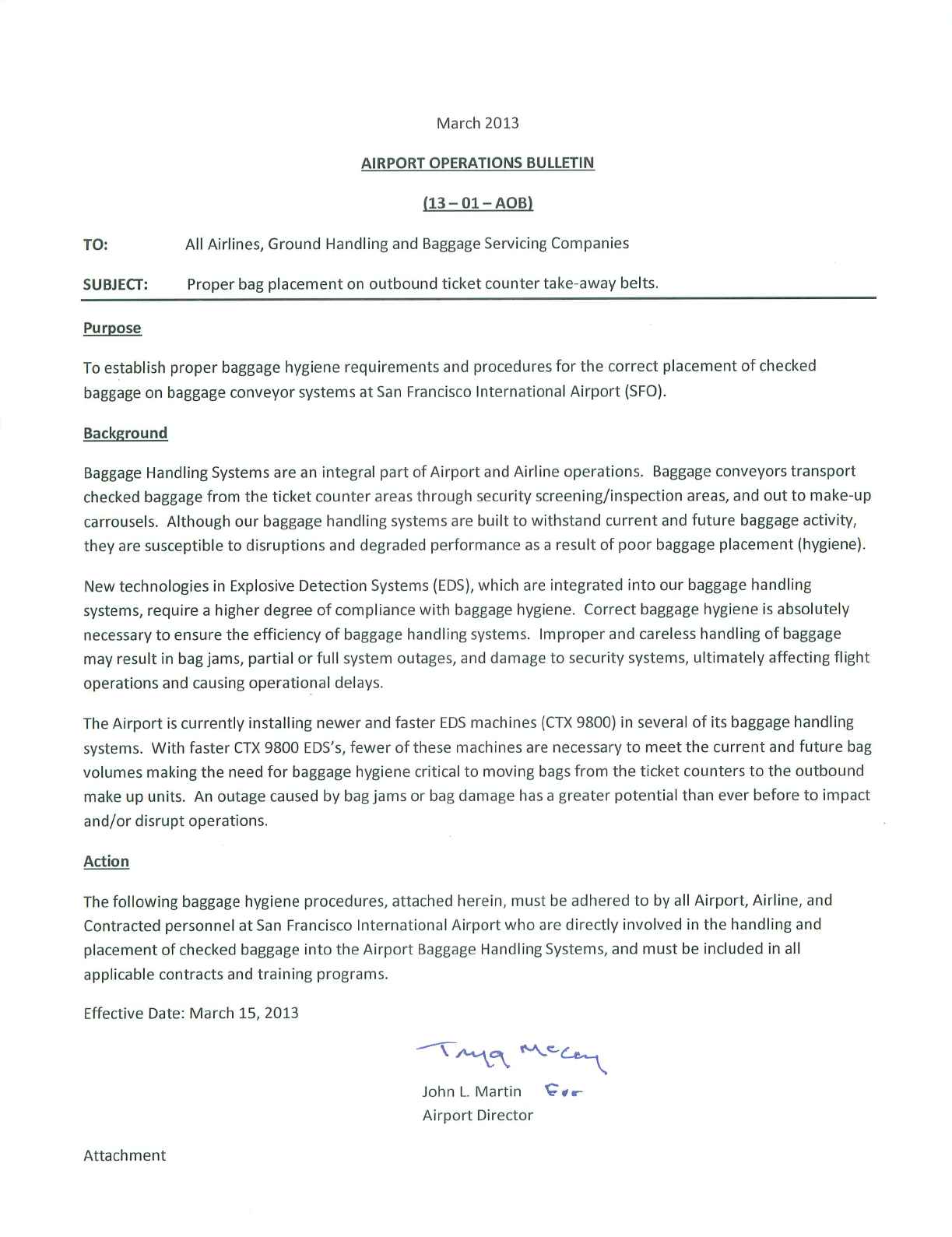
APPENDIX A
BAGGAGE HYGIENE REQUIREMENTS

SAN FRANCISCO INTERNATIONAL
AIRPORT
BAGGAGE HYGIENE POLICY
03/30/13
Prepared by

SAN FRANCISCO INTERNATIONAL AIRPORT BAG HYGIENE POLICY 3/15/13
1
CONVEYOR BAG HYGIENE OVERVIEW
The Airport baggage handling systems transport passenger bags through security screening equipment
that requires bags be tracked throughout their journey from the checked baggage screening area input
conveyors out to the make-up carrousels. Although the baggage handling systems are built to handle
the current bag volumes, the systems have limitations and are susceptible to degraded performance if
certain basic baggage hygiene rules are not followed. Poor bag hygiene results in bag jams, degraded
system performance and even full system outages that affect not only the offender, but all users of the
system. In order to avoid these problems a set of simple baggage hygiene procedures must be
adhered to by everyone who will be using these systems. For this reason, both the TSA and SFO
Airport Authority is requesting that all airlines and baggage service companies reinforce with their front
line supervisors, ticket counter agents and ramp personnel the importance of following proper bag
hygiene procedures and that they go over the following rules that must be practiced at all times.
PASSENGER CHECK-IN PROCEDURES
At the time of passenger check-in, airline customer service agents are requested to ask the passengers
to do the following:
• Remove Straps – Loose straps must be removed from bags or the bags need to be placed in
tubs with all straps inside the tub.
• Remove Old Tags – All old bag tags including tear-off (bingo) tags, cruise ship tags and tour
tags need to be removed from bags.
• Stow Wheeled Bag Handles – Fully retract all bag handles and be sure they are locked in place.
If handle cannot be stowed, agent should place bag on the Oversize line.
• Duffle Bags and Backpacks – All duffle bags and backpacks shall be put into tubs. When tubs
are unavailable, Velcro or snap clasp together all duffel and backpack straps.
• Backpack Hip Supports – Backpack hip supports need to be folded back and tied down around
the backpack so that they do not extend out like wings.
• Remove Dangling Items – All loose ribbons, belts, chains, etc. must be removed or tucked
inside the bag. Utilize airline-provided ID tags as an alternative to bigger personal ID tags.
BAGGAGE CHARACTERISTICS
The table below lists the minimum and maximum baggage dimensions for standard and oversize
conveyor. Items that are larger than the Oversize Conveyor Maximum are considered to be non-
conveyable and must not be placed onto any conveyor, but shall be handled according to manual
oversize procedure. Bags 96” long or greater must be handled according to manual oversize
procedure. General Rule: If an item cannot be easily handled by one person it should not be put on a
conveyor. See the Prohibited Items section for further detail on non-conveyable items. Items that are
smaller than the Standard Conveyor Minimum shall be placed into tubs. See the Tubbing Policy section
for more information.

SAN FRANCISCO INTERNATIONAL AIRPORT BAG HYGIENE POLICY 3/15/13
2
Conveyor Type
Length
Width
Height
Standard Conveyor Maximum
52 "
33 "
34 "
Standard Conveyor Minimum
12 "
12 "
4 "
Oversize Conveyor Maximum
< 96”
48”
36”
TUBBING POLICY
Bag tubs should be used for any item that is irregular in shape or does not have at least one flat
surface, and will have a tendency to roll around or move while being transported on a conveyor. The
following guidelines shall be used for determining which items should be placed into tubs:
• Items that are smaller than the above-listed size for Standard Conveyor Minimum – Place
into a tub.
• Items Weighing Less than 15 Pounds – Place into a tub with the item to the back of the tub to
ensure that it will pass through the EDS machine.
• Duffle Bags – All duffle bags that are within standard bag size (< 54") should be placed into a
tub.
• Roller Duffle Bags – All duffle bags that are within standard bag size (< 54") should be placed
into a tub.
• Garment Bags – Place into a tub.
• Child Car Seats – Place upside down in a tub with the tag on the outside of any plastic wrap and
the plastic wrap tucked under the seat (See Exhibit 3)
• Small Boxes – Place into a tub.
• Shrink Wrapped Items or Items in Plastic Bags – Place into a tub.
BAGGAGE PLACEMENT ON CONVEYORS
Proper placement of checked baggage on the conveyor system will increase the likelihood that bags
travel through the system without issue. Proper placement also helps reduce the number of bags that
require secondary screening which extends the bags travel time from input point to make-up carousel.
The following guidelines should be adhered to whenever possible:
• General Bag Orientation – Baggage and baggage Tubs must be placed on conveyors such that
its longest dimension is in the direction of conveyor travel and the shortest dimension is its
height.
• Bag Gapping – A minimum 12” gap is required between any two pieces of baggage being
placed on a conveyor to ensure that the system can properly track and distribute the baggage.
(See Exhibits 1 & 2)

SAN FRANCISCO INTERNATIONAL AIRPORT BAG HYGIENE POLICY 3/15/13
3
• Two Wheeled bags – Place onto conveyor with wheels up and with the wheels trailing (bag tag
forward).
• Four Wheeled Bags – Place onto conveyor on its side with the wheels trailing and the bag tag
forward.
• Overstuffed Bags – Overstuffed baggage with rounded surfaces must be placed on the largest
flat surface of the bag, or in a tub.
• Large Boxes – Place on conveyor such that the longest dimension is in the direction of conveyor
travel and the shortest dimension is its height.
• Golf Clubs – Place onto the Oversize conveyor line.
• Items Weighing More than 120 Pounds – Place onto the Oversize conveyor line.
PROHIBITED ITEMS – Not Conveyable
The following items are not allowed to be placed directly onto any conveyor. These items, and items
with similar characteristics, must be handled by the current manual oversize procedures. This list of
prohibited items is not all-inclusive, but serves as an example of non-conveyable items:
• Surf boards
• Skim boards
• Skis and snow boards
• Guitars
• Gun & Rifle Cases
• Hockey sticks
• Baseball bats
• Shovels
• Crutches
• Walkers
• Any item less than 6 inches in height unless it will fit in and is placed into a tub.
• Any item longer that 96” (Note: that the 96” calculation includes straps, handles tags and
any other items that would add to the length of the bag.
CHECKED ITEMS SUSCEPTIBLE TO DAMAGE
The baggage handling system transports baggage from the input points through security screening
process and out to the make-up carousels in a manner that does not damage the contents of the

SAN FRANCISCO INTERNATIONAL AIRPORT BAG HYGIENE POLICY 3/15/13
4
average checked bag. This does not mean however that baggage is not jostled and transported in a
manner that may cause damage to the bags contents. The following items if placed directly on the
conveyor or packed in baggage cannot be guaranteed to make it through the system without damage
and therefore should be handled, at the airlines discretion, as oversized or non-conveyable:
• Glassware
• Porcelain objects
• Glass beverage containers including those for wine and hard alcohol
• Electronics
• Musical instruments
• Anything warranting a “Fragile” or “Handle with Care” tag.
BAG TAG PROCEDURES
The baggage handling system depends on being able to read airline generated bag tag bar codes for
tracking the bag through the screening process and delivering it to the correct make-up unit. Following
certain basic bag tag procedures helps increase the likelihood that the tag will be read correctly and
they are as follows:
• Clearly Present Barcodes – Bag tags must be placed on the bag and then onto the conveyer in
such a manner that the tag is clearly presented and the bar codes are unobstructed. This
means tags cannot be wrapped around handles, placed under bags in tubs or covered up by
any part of the bag.
• Remove Old Bag Tags – All old bag tags and tear-offs (bingo) tags must be removed to avoid the
automatic tag reader getting conflicting bar code information.
• Place Tags Outside Plastic Bags – Protective plastic bags can be placed over baggage and
placed directly on the conveyor system on the condition that the bag tag is either applied to the
outside of the plastic bag or is attached to the item inside the plastic bag and then pulled out
through a hole in the plastic bag so that the tag is not obstructed by the opaque plastic bag.
• Limit Use of Expedite Tags – Expedite tags generally do not conform to IATA standards and
therefore can’t be read and properly processed by the baggage handling system.
• Report Poor Tag Print Quality - Poor quality barcodes on tags with incomplete printing or
streaking reduces the probability that the barcode can be read or is even valid. When poor
quality tags are noticed a service call should be made to have the printer serviced.
• Tear Off or “Bingo” Tags – Do not place tear off tags on the bags. They do not increase the bar
code read rate and they litter the system and can damage the screening equipment.
• Use Fallback Tags – The use of locally printed IATA compliant fallback tags is recommended
whenever an airline loses the ability to print tags from its corporate system. These tags are
properly formatted to be read by the baggage handling system and ensure the highest level of
system performance. When fallback tags are used on bags in tubs, do not place the fallback
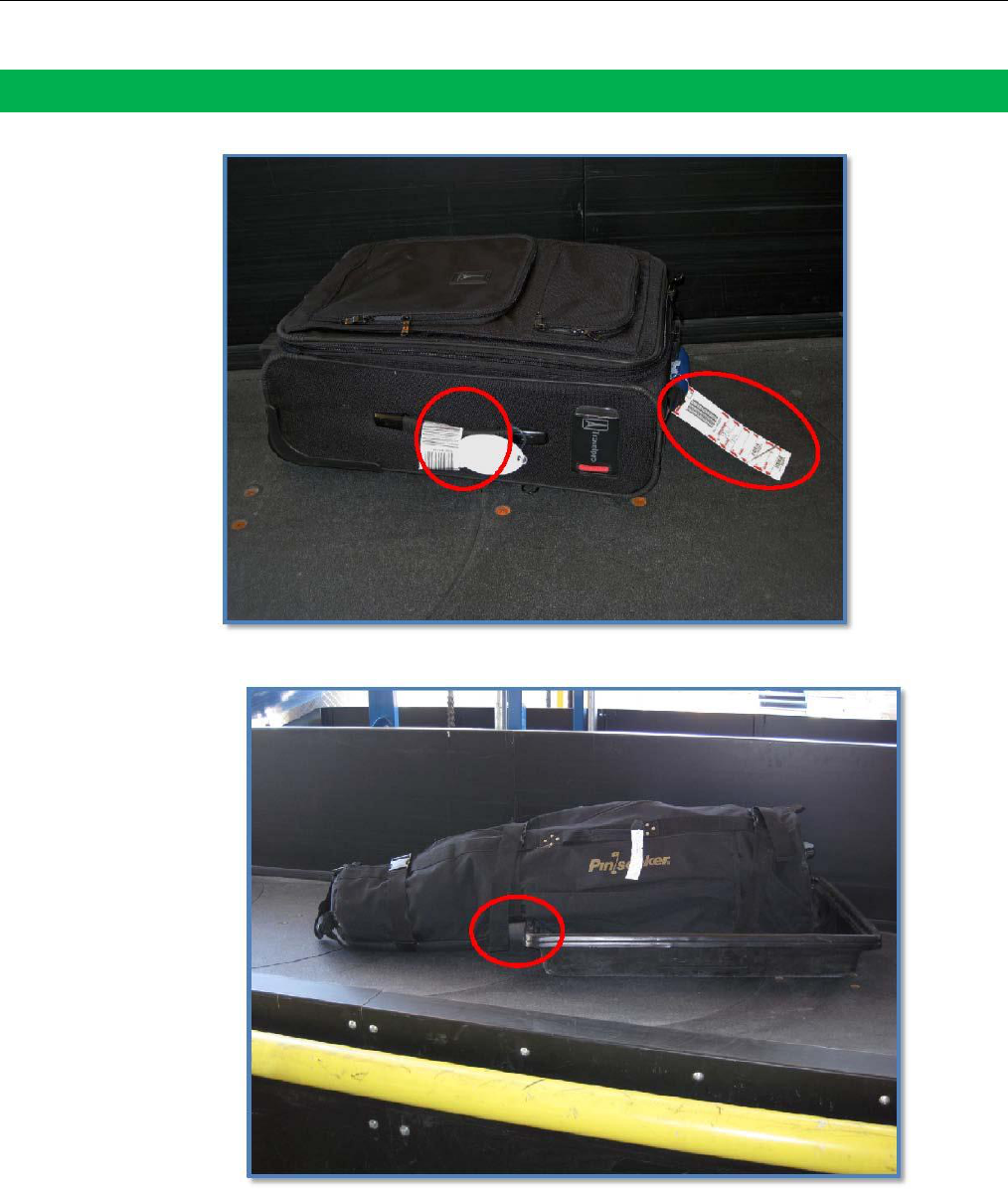
SAN FRANCISCO INTERNATIONAL AIRPORT BAG HYGIENE POLICY 3/15/13
5
tags directly onto tubs.
PROBLEM ITEM EXAMPLES
Photo 1 – “Unrecognized Tag” caused by multiple barcodes.
Photo 2 – “Jam” caused by one bag being detected as two as a result of gap under bag.
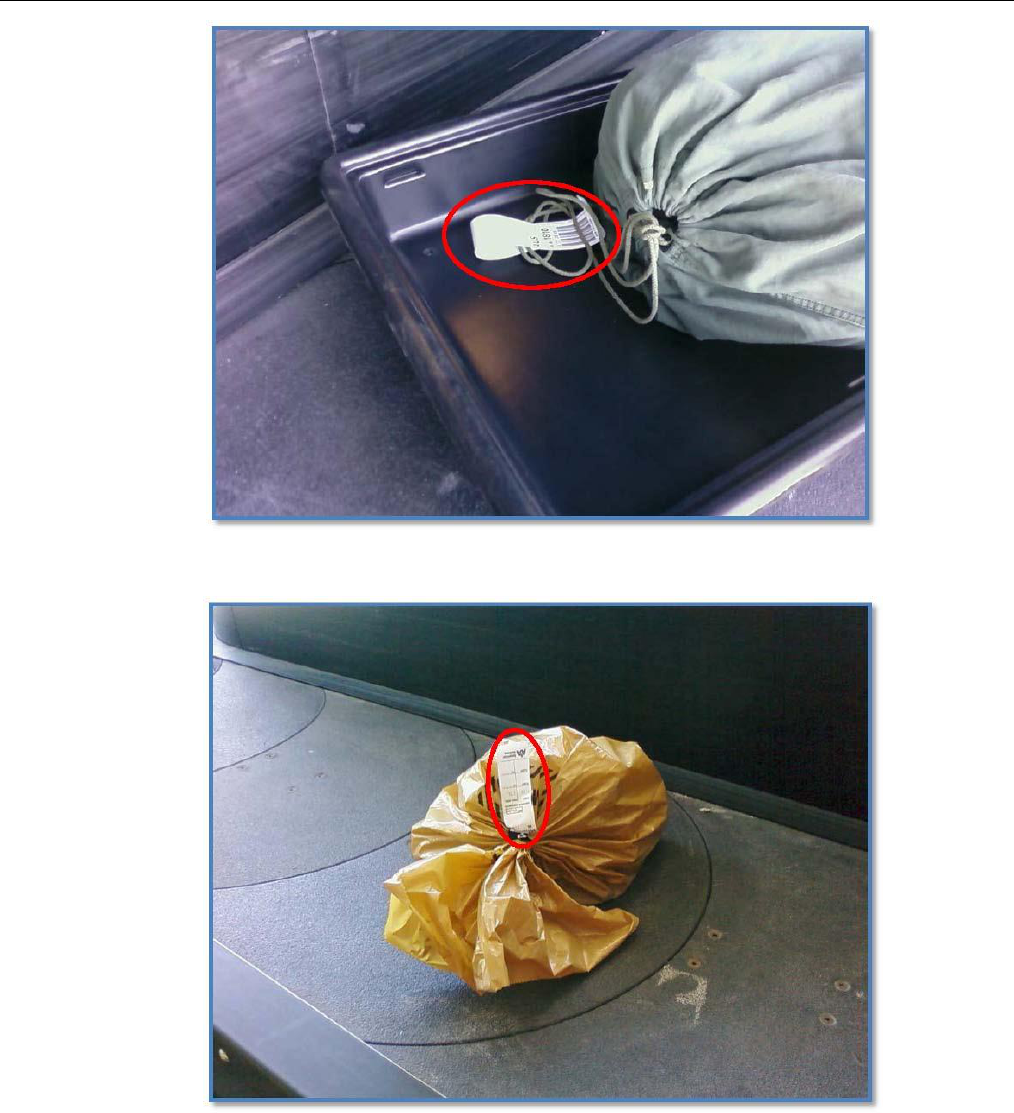
SAN FRANCISCO INTERNATIONAL AIRPORT BAG HYGIENE POLICY 3/15/13
6
Photo 3 – “No Read” caused by poor barcode presentation and partially blocked barcode.
Photo 4 – “No Read” caused by COMAIL barcode not fitting sort parameters and unreadable barcode.
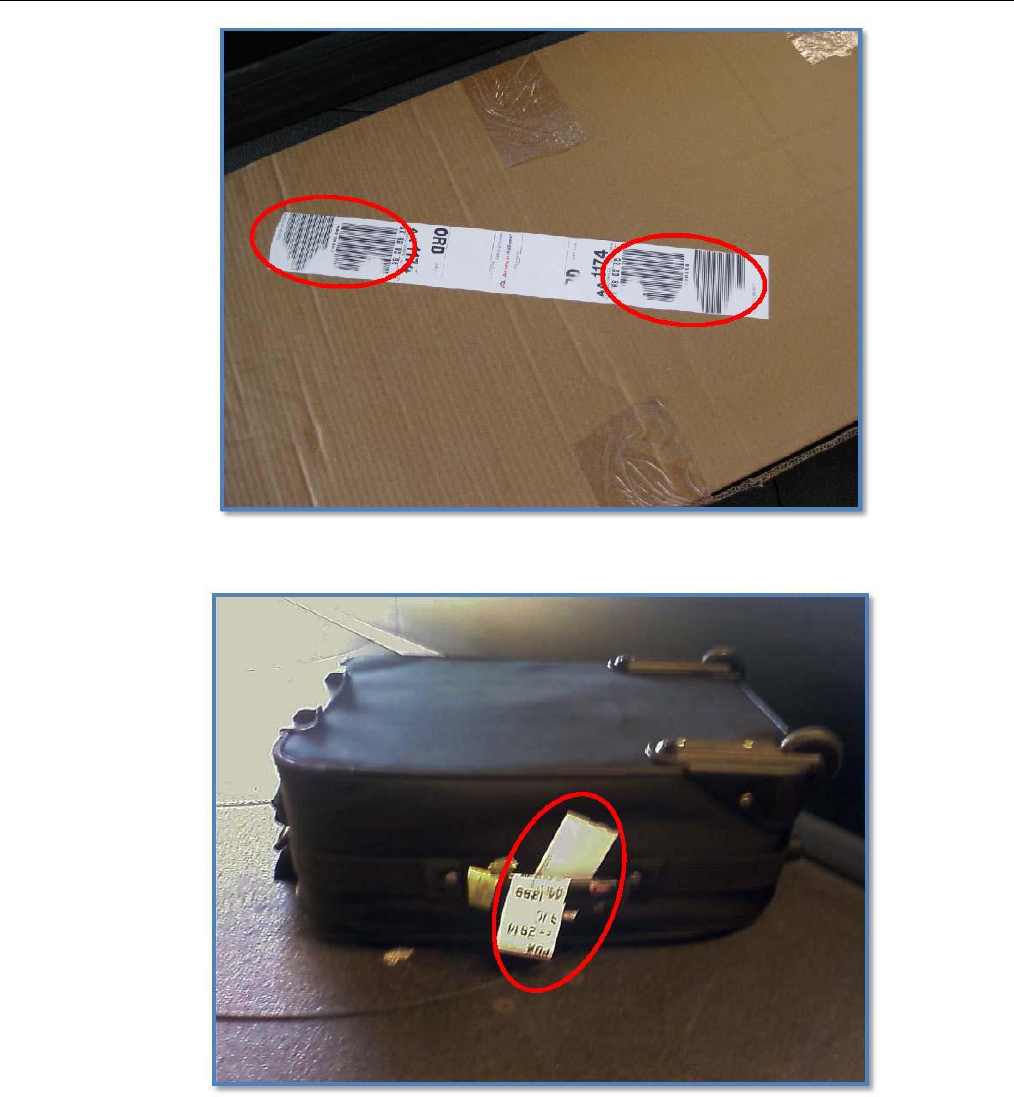
SAN FRANCISCO INTERNATIONAL AIRPORT BAG HYGIENE POLICY 3/15/13
7
Photo 5 – “No Read” caused by poor tag print quality.
Photo 7 – “No Read” caused by tag being wrapped around handle.
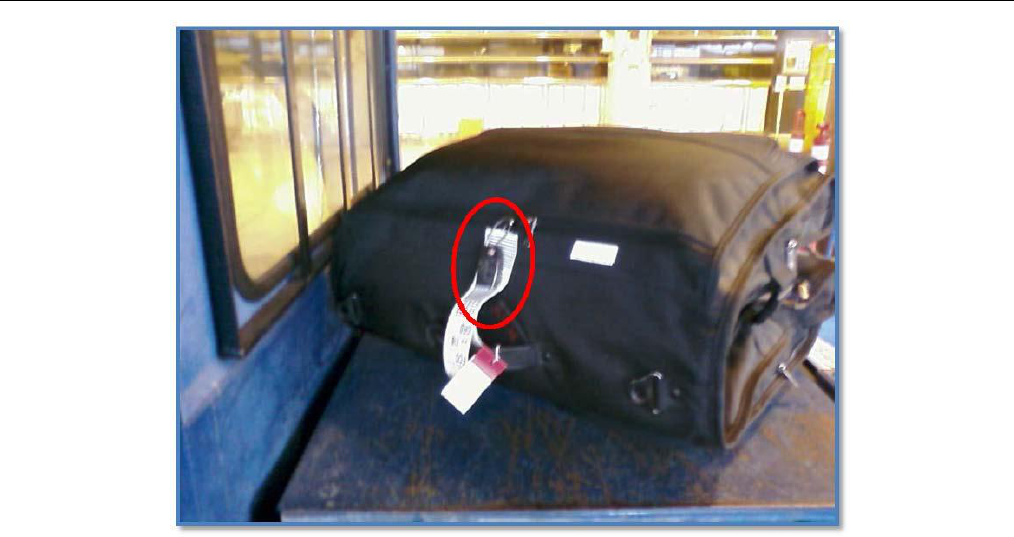
SAN FRANCISCO INTERNATIONAL AIRPORT BAG HYGIENE POLICY 3/15/13
8
Photo 8 – “No Read” caused by barcode being blocked by object on bag.
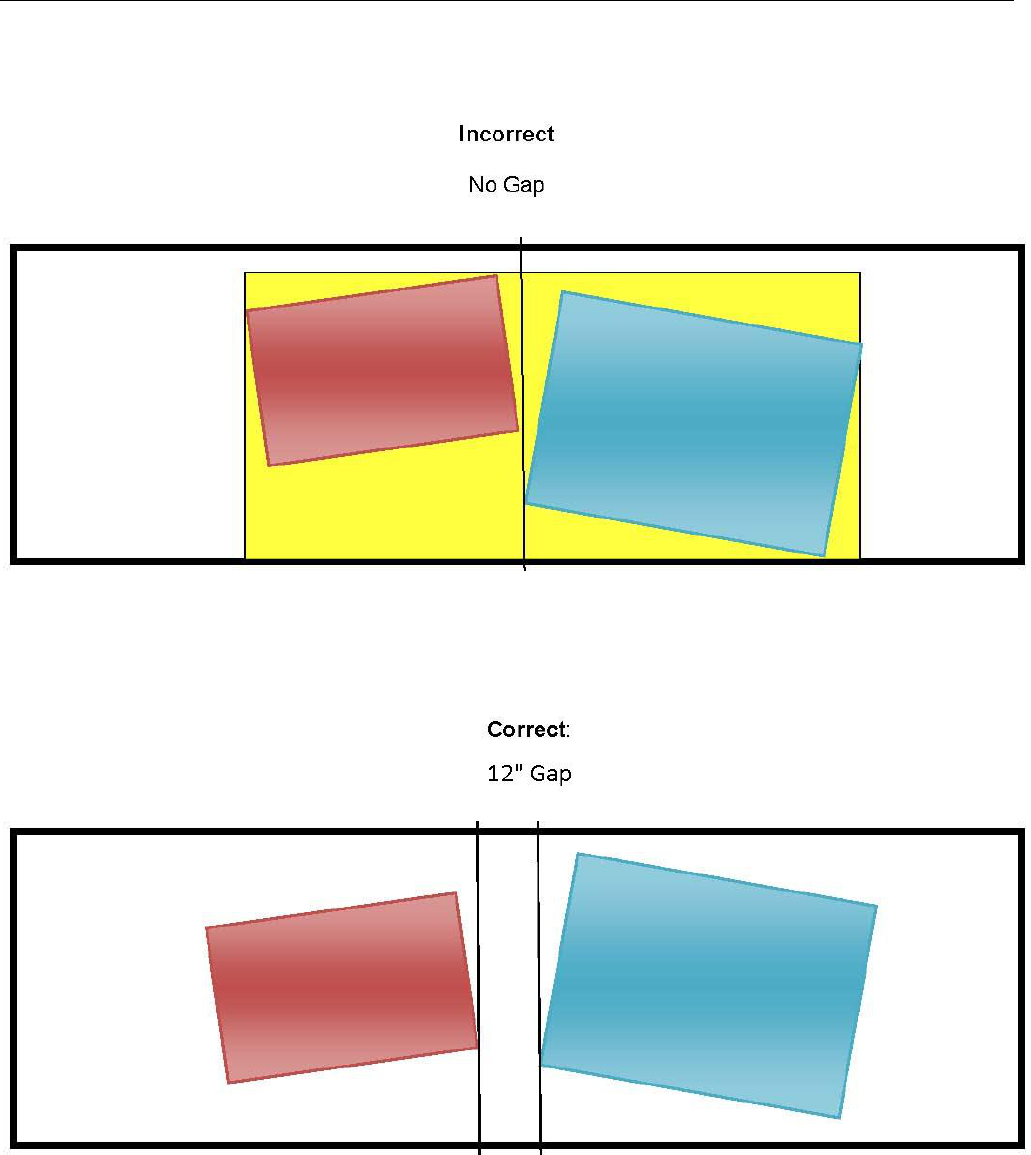
SAN FRANCISCO INTERNATIONAL AIRPORT BAG HYGIENE POLICY 3/15/13
9
Exhibit 1 – Improper baggage gapping.
Exhibit 2 – Proper baggage gapping of at least 12 inches.
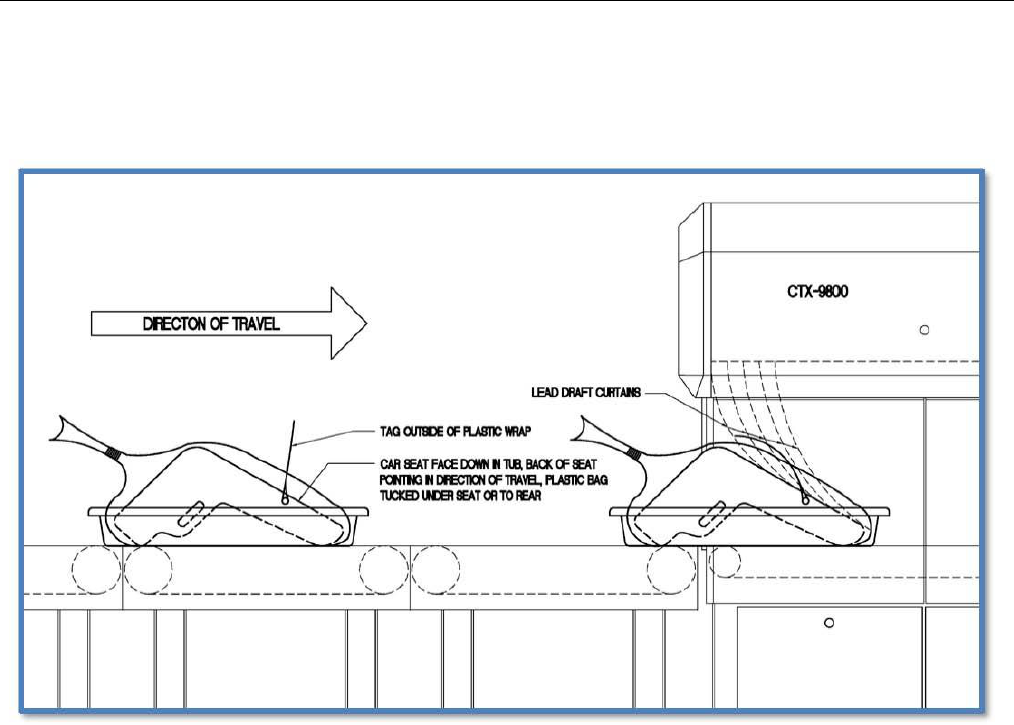
SAN FRANCISCO INTERNATIONAL AIRPORT BAG HYGIENE POLICY 3/15/13
10
Exhibit 3 – Proper placement of child car seats into tubs.
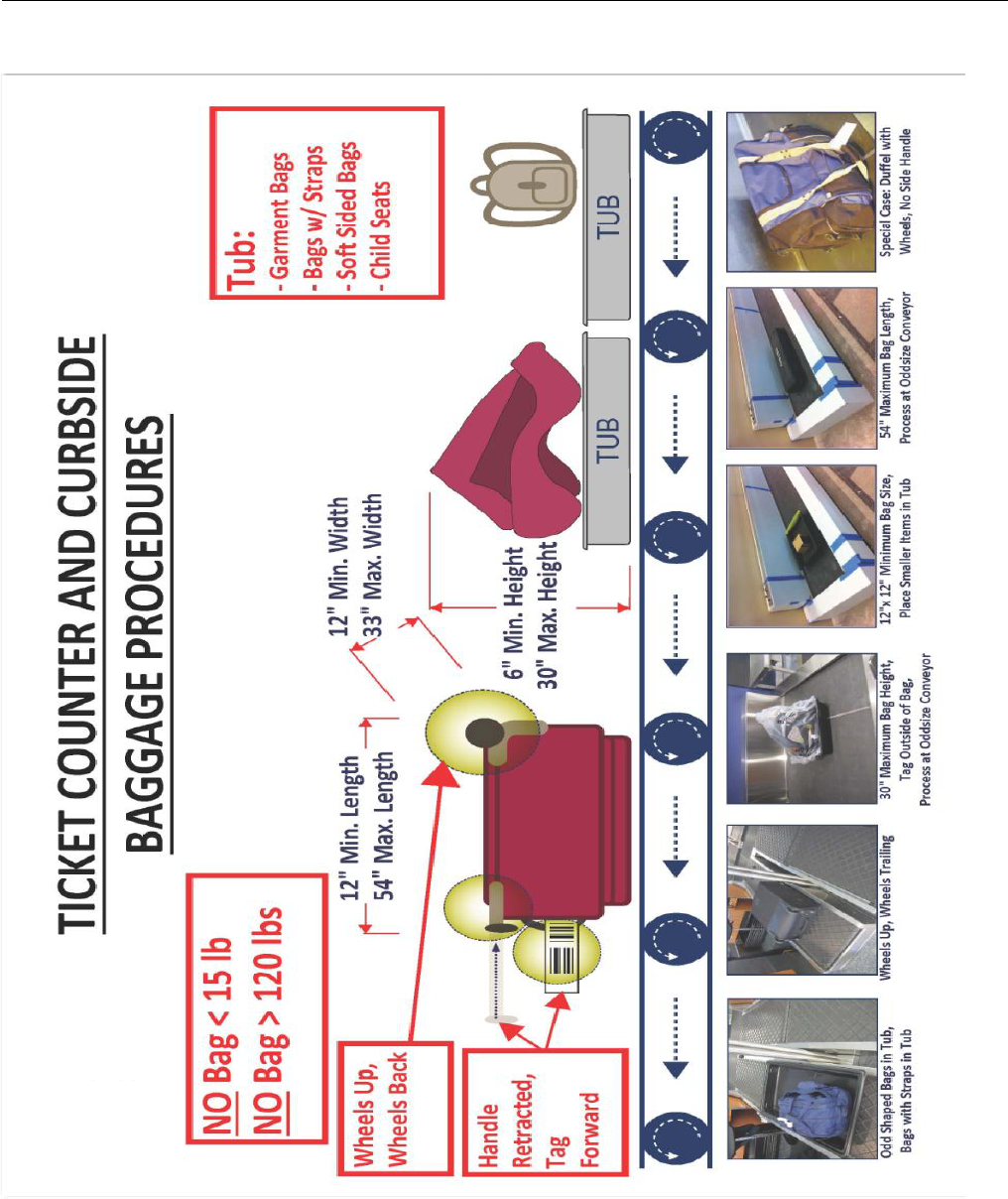
SAN FRANCISCO INTERNATIONAL AIRPORT BAG HYGIENE POLICY 3/15/13
11
Exhibit 4 – Bag Hygiene Placar
